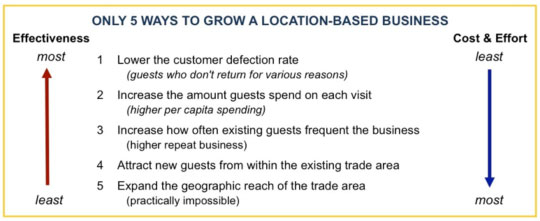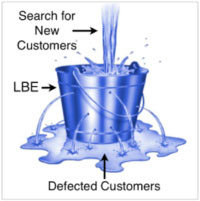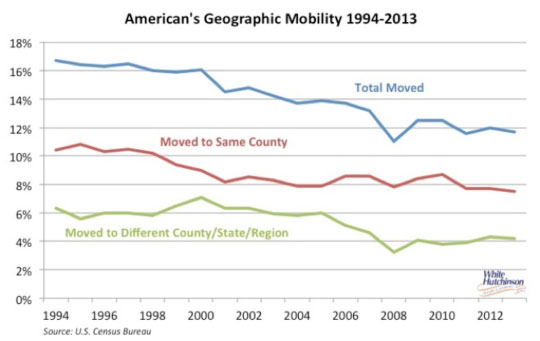
Vol. XIV, No. 2, February-March 2014
- Editor's corner & travelogue
- Why entertainment venues should fear digital technology
- Two Foundations Entertainment Universities on the horizon: one is free and the other has an early bird discount
- Are You Old School?
- Spectator sports growing in popularity & on the decline
- Top design trend - Immersive design
- Back to the basics; the only five ways to grow your business
- Importance of ambiance
- Is bowling in the gutter?
Back to the basics; the only five ways to grow your business
With all the details and complications of running an FEC or other type of location-based entertainment (LBE) center that is a combination of at least three different hospitality businesses - entertainment attractions, food and beverage and group events - all with their individual complexities, it is easy to lose focus on the basics of what is really important to growing revenues and profits. In reality, there are only five ways, yes only five ways to grow any type of location-based business, some being far more productive in terms of management and money invested than others. Too often owners are seduced into the less productive ones as they seem to be the best prospects for growth, when in fact they are not.
So no more suspense. Here's the five in decreasing order of ease to accomplish and return on management/staff time effort and cost:
- Decrease defections (customers who don't return)
- Increase per capita expenditures from existing customers
- Increase frequency of visits from existing customers (#2 and #3 are basically equal in return on effort and cost)
- Get new customers from the existing geographic trade area
- Expand the trade area (next to impossible)
Surprised that the first three focus entirely on existing customers? That's where the upside bread and butter is. It's not chasing after new customers in #4 and #5, which is how too many businesses assume is the best way to grow.

The first one, decreasing defections, is where too many businesses fail to focus. This is known as the leaky bucket where pissed-off or unsatisfied customers who don't return are continually leaking out the bottom so you are forced to chase after new ones. Our company has analyzed many existing FECs and LBEs for clients who wanted to improve sales and profitability. Consistently, we have found customer defection rates of anywhere from 25% to 50% and higher, meaning 25% to 50% of existing guests abandon the business each year. Just to stay even, these businesses must continually market to recruit large numbers of new guests to replace the ones they've chased away, the ones who never come back (and probably tell their friends not to, as well!).

Our company is currently working with a membership-based lifestyle recreation center that is looking to expand. They want to grow, but are unsure of exactly what new things they need to offer members to grow membership value and to increase membership retention (decrease defections, members who cancelled or don't renew their memberships). When we analyzed the information they had on membership cancellations/nonrenewals, we discovered that they were not questioning leaving members in enough depth to really determine the true root cause of their cancellations, so we didn't have good information on what needed to be done to plug the hole in the leaking bucket.
Membership-based or not, every business needs to conduct continuous in-depth analysis of defections so there is a clear understanding of what needs to be improved to increase loyalty. If you can't identify which customers defected, periodic surveys of customers as they exit the FEC or LBE (exit surveys) can uncover the issues. These should be done by a person, preferably a woman, with the needed social and communication skills to probe to uncover the root cause issues.
The truth is that focusing on the first three, and especially the first - pleasing existing guests so they don't defect - will usually take care of attracting new customers through positive word-of-mouth and word-of-social-media marketing. Focusing and investing on current guests rather than the ones you don't have realizes the greatest return on investment.
Focusing on retaining existing guests accomplishes two things. First, you increase your sales by generating more revenue from existing customers over a longer period of time. Studies have shown that even a 5% decrease in defections can result in a 25% increase in profits. Yes, that dramatic of a profit increase as almost all the increased revenue falls to the bottom line with the exception of cost of goods sold. Secondly, you end up doing a better job of attracting new guests than the traditional route of advertising and discounting. You produce guests who are really happy with your business and want not just to return, but to recommend it to their friends, as well. Powerful? You bet! Think about how you choose which new restaurants to visit. Would you be more likely to visit one with a pretty ad or one that a friend praised to the skies? Yeah, we thought so.
When we talk about defections, we sometimes hear a response that there is nothing a center can do about guests who move out of the community. That is true. However, moving guests is not that significant a factor. Our company has done analysis of household moving statistics for households that move outside of a typical LBE trade area (when households move, many move to the same basic area). The percent of Americans that move each year has been on a steady decrease. The result is that we estimate that today only 5% of households who would be typical customers of LBEs actually move outside of a LBE's trade area each year.

If we go back and look at overall typical defection rates of 25% to 50%, that means the vast majority of guests who never return to an LBE do so for reasons other than moving away. It's rather frightening when you think about it. Even using the best-case scenario of a 25% defection rate, the LBE is effectively chasing 20% (25% minus the 5% who moved), more than one-fifth of its guests away each year. That's an awful big hole in the bottom of the bucket.
What does this mean if you don't plug the leaks of defecting customers? It means eventual disaster, as the time arrives when there are no longer enough new residents in the market area who can be attracted at considerable cost to replace all the ones that leaked out of the bottom of the bucket.
Vol. XIV, No. 2, February-March 2014
- Editor's corner & travelogue
- Why entertainment venues should fear digital technology
- Two Foundations Entertainment Universities on the horizon: one is free and the other has an early bird discount
- Are You Old School?
- Spectator sports growing in popularity & on the decline
- Top design trend - Immersive design
- Back to the basics; the only five ways to grow your business
- Importance of ambiance
- Is bowling in the gutter?



